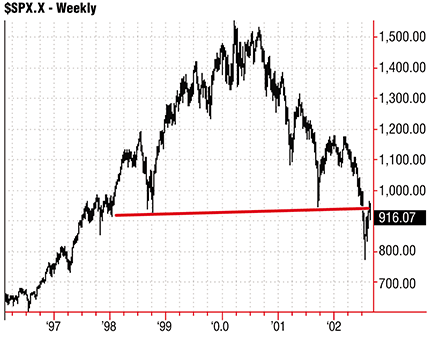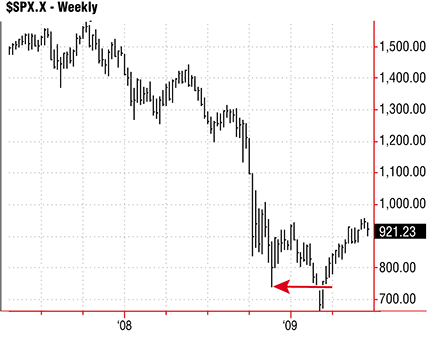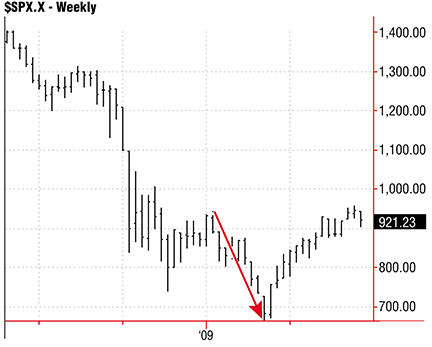AT THE CLOSE
Looked At Market Sentiment Lately?
The volatile markets make for uneasy market participants. Keep a calm, cool, collected eye out and don’t get swept away by the hysteria of the crowds.
In the summer of 2002, market participants anxiously watched the apparent neckline breach of a massive head & shoulders top formation on the Standard & Poor’s 500. From the March 24, 2000, high of 1,552.87 to the September 21, 2001, low of 944.75, the pattern measured 608 points. Subtracting that from the neckline at 944 produced a downside target of 336 (Figure 1).

Figure 1: head & shoulders top formation. From the March 24, 2000, high of 1,552.87 to the September 21, 2001, low of 944.75, the pattern measured 608 points. Subtracting that from the neckline at 944 produced a downside target of 336.
The existence of the pattern was widely noted. Peter Brimelow of Forbes reported on January 7, 2002, that Richard Russell, publisher of the Dow Theory Letters, had identified it:
Massive Head And Shoulders Overshadows Market
Russell’s call, therefore, has made chartists sit up and take notice.
Interestingly, none of the other letters that regularly note head and shoulders patterns — for example, The Dines Letter and Investors Intelligence — are talking about it now. Partly this may be because this particular head and shoulders is long term; it only becomes evident when the market is looked at over a six-year period or more. Most advisers don’t take such a long-term focus. That’s what makes Russell different: He takes a very long view.
On December 2, 2002, David Simons of Forbes reported that in spite of the Dow Jones Industrial Average (Djia) being up 18% in eight straight weeks, the pattern was still something to be reckoned with:
When Head And Shoulders Above Isn’t Good
Optimists say the late-autumn rally has created a double bottom, which is a strong base for a long uptrend. But chart reading rules say that will be confirmed only if the market breaks decisively above the August high.
Head and shoulders patterns precede significant declines at least 80% of the time. That’s better than twice the percentage of rallies from double bottoms that break out to new high ground.
In my Stocks & Commodities interview in August 2002, I voiced skepticism about the pattern based on the measured target and prevailing market sentiment. As it turned out, the S&P 500 put in the low less than 10 weeks later in October 2002 at 768.67 and continued upward for five more years. More recently, I was able to warn clients ahead of the impending September 2008 crash. I also identified the March 2009 low and guided them back into the market in a timely manner.
How was it possible to accurately analyze and capitalize on these chaotic market conditions? Actually, it is easier than it looks because of a simple paradox. Compared to the difficulty of timing the market on a daily basis, a bottom that forms after a downtrend (or a top that forms after an uptrend) has already been in place for a long time — especially in periods of high volatility and uncertainty — is relatively straightforward.
Market extremes
Human nature makes it hard to resist buying high and selling low. Good news is always found near tops, while bad news is always found near bottoms. We are designed to feel most confident and have the most conviction to act when there is a massive amount of public opinion that concurs with the fundamentals. By and large, the typical human instinct (or “gut,” if you will) is simply not geared for trading.
At the extremes, market participants appear to lose all discipline and react on pure emotion. At the same time, their belief in the prevailing direction of the trend becomes so entrenched that extrapolating it in linear (or even parabolic) fashion becomes the norm. The crowd is so adamant in its view that any other opinion is not only dismissed but openly ridiculed, even attacked.
Let’s contrast two perspectives. After the close on March 6, 2009, the day the S&P 500 put in a low of 666.79 before a 43% rally into June 2009, Cnbc ran a story that embodied all the hallmarks of a big turn:
Picking a Market Bottom: Why the Pros Are All Wrong
Some of the smartest minds on both Wall Street and Washington have tried numerous times to identify an ultimate low for stocks and have failed — in some cases miserably. The bookend collapses of both Bear Stearns and Lehman Brothers served in the minds of some as critical points of capitulation. For others, the “bottom” was election-related. Still others tied their bottom calls to various legislative developments. So far such pronouncements have had one thing in common: They have all been wrong.
That same afternoon, I noted that panic had reached a crescendo:
Sentiment Alert: Big Downward Projections
One of the kisses of death on the upside are analysts projecting ever higher highs after a huge move up. Remember $250 Qcom? $250 oil? Remember Arjun Murti? Exactly.
The same thing happens near significant, tradeable bottoms. After a long move down, analysts that “got it right” (even if it was for the wrong reasons) begin to appear on TV frequently to predict ever lower lows, except the targets are insane in terms of percent loss.
Market sentiment
March 2009 was a classic display of what Justin Mamis described in his classic tome, The Nature Of Risk. The discouragement phase of the investor sentiment cycle takes place in a downtrend where a significant decline has already taken place. Contrarians who went in too early — the value players who stepped in when the market seemed “cheap enough” after the initial decline — experienced a severe case of discovering that the light at the end of the tunnel was actually an oncoming train and found out that they were in no position to average down.
As investors continue to dump stocks, short-sellers become bold and bearish. Their views are supported by bad news and poor economic data. Prognostication of lower prices to come is certain in their minds. This is when everyone knows that the market cannot ever go up again, and that anything, even cash, is preferable to owning stocks. It is the phase during which the pain increases because the “known” reasons seem to be getting worse and worse and investors feel as if the situation will be even worse tomorrow.
As for the head & shoulders formation seen in 2002, the failure of the pattern should not be viewed as a failure of technical analysis. As Justin Mamis remarked, “The one eternal aspect of every market top is that it occurs before we’re ready for it.” If anything, large patterns that can be clearly seen with ease by everyone often become reverse self-fulfilling prophecies because individuals have had time to brace for it. Many might have sold in anticipation of or shortly after the break of the neckline, and after a long downtrend, the group that is the last to know becomes the last to sell. Once they are gone, the road is paved for a move to the upside.
Trading the markets
Once we are able to bear witness to the market’s gyrations to perceive prevailing investor sentiment, the act of trading becomes mechanical. I have been asked many times how it was possible to make the call in March 2009 (Figure 2). It basically came down to two observations that I could set up as an if-then scenario.

Figure 2: trading the markets. The March 2009 price action was a test of the November 2008 low. On a break of the November 2008 low, investors gave up hope and sold while some traders went short on the downside breakout.
First, no matter how ugly things looked, the March 2009 price action was a test of the November 2008 low. Traders often initiate using what I call the “setup of last resort”: the breakout. In this case, the economic news was so grim that troubled banks were expected to be nationalized. On a break of the November 2008 low, investors gave up hope and sold, while some traders went short on the downside breakout.
Second, because the downtrend had been in place for over a year, moving to the weekly bar chart helped provide a clear perspective (Figure 3). The logic is simple. Price bars can be classified into four types: up, down, inside, and outside. An up bar forms when the high and low of the current bar is higher than that of the previous bar. A down bar forms when the high and low of the current bar is lower than that of the previous bar. An inside bar is one where price action of the current bar is confined to the last bar’s high and low.

FIGURE 3: WEEKLY CHART. Going into the March low saw at least four down bars in a row as part of a big downswing. In order to break the pattern, up bars must form, and in order to do that, the high of the previous bar must be taken out.
We can extend the logic and generalize that a series of down bars and inside bars form a down swing. In this case, going into the March low, we saw at least four down bars in a row as part of a big downswing. In order to break the pattern, up bars must form, and to do that, the high of the previous bar must be taken out.
Putting together the two observations, I deduced that if the sellers of the breakdown were wrong, then the test of the bottom would hold after a quick violation of the November 2008 low of 741.43. I also deduced that if the market were to change direction from down to up, then the March 6, 2009, high of 727.14 would have to be taken out to the upside.
The area between 727.14 and 741.43 became a gray zone, and depending on the aggressiveness of the trader, more indication that a reversal to the upside in the form of a close above 741.43 took place one week later. Appropriate position sizing was implemented to manage risk.
What it all comes down to
In conclusion, each of us must continually cultivate independent, critical thinking in order to get through times of euphoria and despair. We must not be our own worst enemy. It is not an easy task to avoid being caught up in the madness of the crowds, but surviving turbulent markets depends on it.
Suggested reading
Brimelow, Peter [2002]. Massive Head And Shoulders Overshadows Market, www.forbes.com/2002/01/07/0107watch.html
Cnbc. Picking a Market Bottom: Why the Pros Are All Wrong, www.cnbc.com//id/29550282
Gopalakrishnan, Jayanthi [2004]. Helene Meisler Of TheStreet.com, interview, Technical Analysis of Stocks & Commodities, Volume 22: June.
_____ [2002]. Teresa Lo, interview, Technical Analysis of Stocks & Commodities, Volume 20: November.
Hartle, Thom [1995]. The Nature Of Risk: Justin Mamis And The Meaning Of Life, interview, Technical Analysis of Stocks & Commodities, Volume 13: August.
Lo, Teresa [2004]. Swing Trading With Swing Charts, Technical Analysis of Stocks & Commodities, Volume 22: February.
_____ [2004]. Set Up Your Trades With The Swing Indicator, Technical Analysis of Stocks & Commodities, Volume 22: September.
_____ [2009]. Where We Are In The Cycle, guest column, www.jasonkelly.com/2009/03/commentary-from-invivoanalytics.html
_____ [2009]. Sentiment Alert: Big Downward Projections, www.invivoanalytics.com/2009/03/06/sentiment-alert-big-downward-projections/
Simons, David [2002]. When Head And Shoulders Above Isn’t Good, www.forbes.com/2002/12/02/cx_ds_1202simons.html